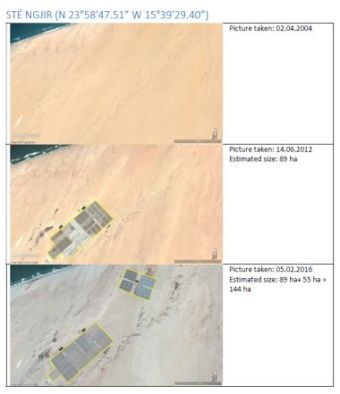
Based on assessments of satelite images, WSRW has calculated how the plantations in occupied Western Sahara developed from 2003 until today.
The pictures above show the plantation Sté Maraîchage du Sahara 3 at location N 23°36'14.07” W 15°47'28.12” in occupied Western Sahara, for the years 2005, 2010 and 2016. Photos: Google Earth.
WSRW today publishes the research note ‘The expansion of plantation infrastructure in occupied Western Sahara, 2003-2016’ where we estimate the development of each of the 12 plantations in the territory Morocco holds under occupation.
Download the study here.
The study is done by visual analysis of three sets of satellite images provided by Google Earth, with three different sets of photos: from 2003/2004/2005, from 2010/2011/2012 and from 2016.
It shows that approximately 1000 hectares are today under plantation in occupied Western Sahara. Several of the plantations are also said to have been investing heavily since the last set of satellite photos were taken in February this year.

This research note contains two main findings:
- There is a continued growth of the plantation acreage. WSRW found a large increase in infrastructure from 2003-2005 (150 ha) to the years 2010-2012 (841 ha). Since then, the acreage has increased even more (963 ha in 2016). As the present analysis is made with conservative figures, the acreage is probably larger.
- There is a remarkable timing of the first boom in infrastructure. The large increase of infrastructure at the time when Morocco and the EU were negotiating a trade agreement, suggests that the Moroccan government and the Moroccan/French companies involved had expected the trade agreement to go through. After all, the EU is the main market for the agriculture products grown in Dakhla. From the first to the second image set, the number of plantations increased from 4 to 12.
In 2012 WSRW published the report ‘Label and Liability - How the EU turns a blind eye to falsely stamped agricultural products made by Morocco in occupied Western Sahara’. The now published research note adds to the findings of that initial study. Even though no state in the world recognises Morocco's claims to the territory, the EU presently applies the agreement with Morocco to goods coming from a territory which is outside of the internationally recognised borders of Morocco. On 10 December 2015, the Court of Justice of the EU ordered set aside the agreement insofar as it allowed products from Western Sahara into the EU on a free trade basis. There are no indications that the EU, Morocco, the exporters or the importers are honouring the court's decision from 2015.
19 July 2016, the Court of Justice of the European Union is hearing the two parties in the court case Frente Polisario v. European Council. The EU appealed he decision of the first instance over technicalities: that the court has no mandate to express itself on such international matters, and that Polisario could not be granted a right to speak on behalf of the people of the territory in an EU court.
Morocco invaded parts of Western Sahara in 1975, against the opinion of the International Court of Justice.
All plantations are also made available via this Google Earth file (requires your computer has Google Earth installed).
New report: Certified occupation
International certification standards embellish Morocco’s controversial trade with fisheries and agricultural products in occupied Western Sahara, new report documents.
Certification giant SGS points fingers elsewhere
SGS blames everyone else for mistakes on MarinTrust certificates it had issued to Moroccan companies in occupied Western Sahara.
New report: Greenwashing Occupation
Out now: WSRW today publishes a new report outlining the massive - and deeply problematic - renewable energy projects that Morocco is developing in occupied Western Sahara.
GMP+ does not check if “sustainable” fish is legally caught
The world’s largest certification scheme for “safe and sustainable animal feed” does not check whether its certified fish feed companies source from illegal fisheries in occupied Western Sahara, where catches violate the Saharawi people’s right to self-determination.



